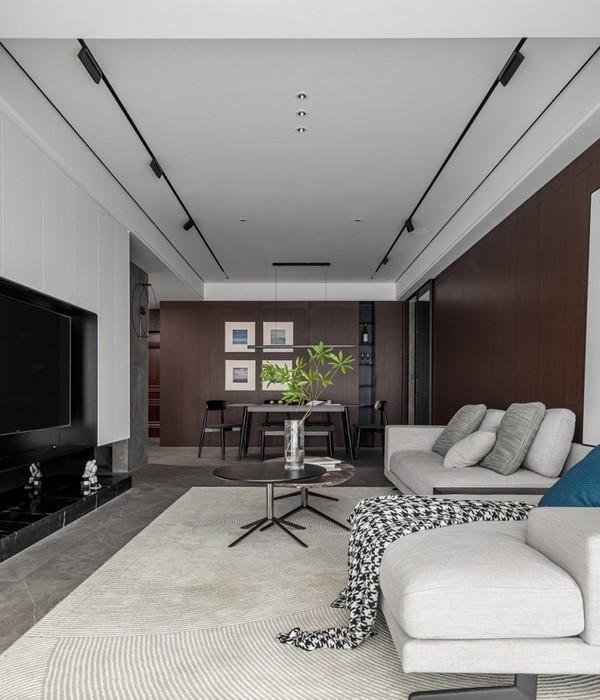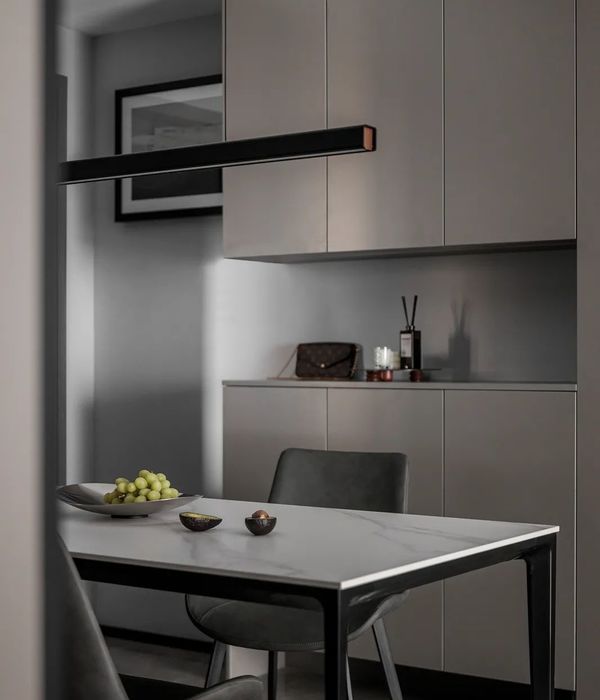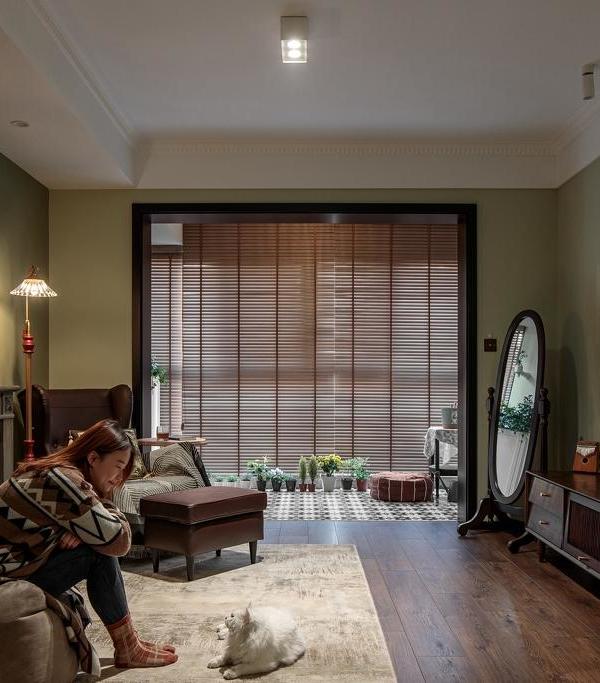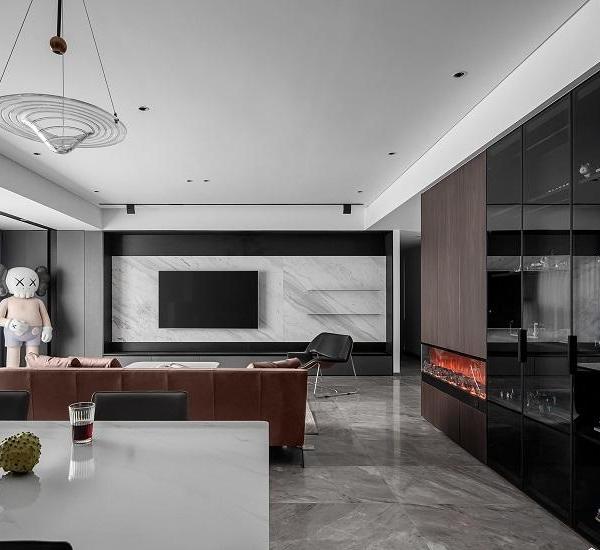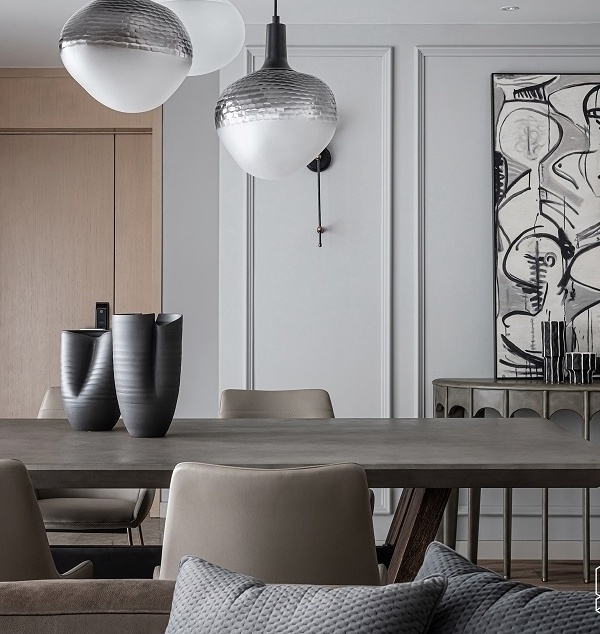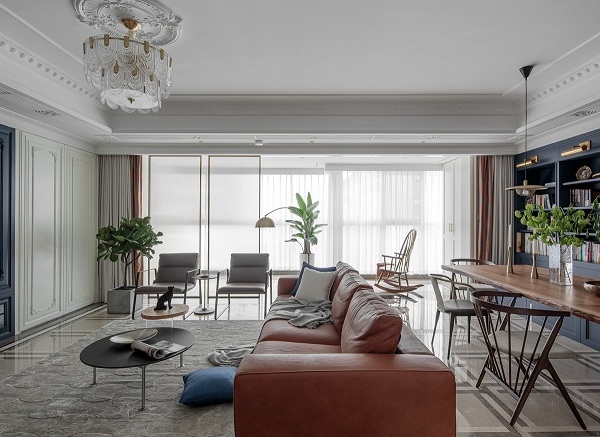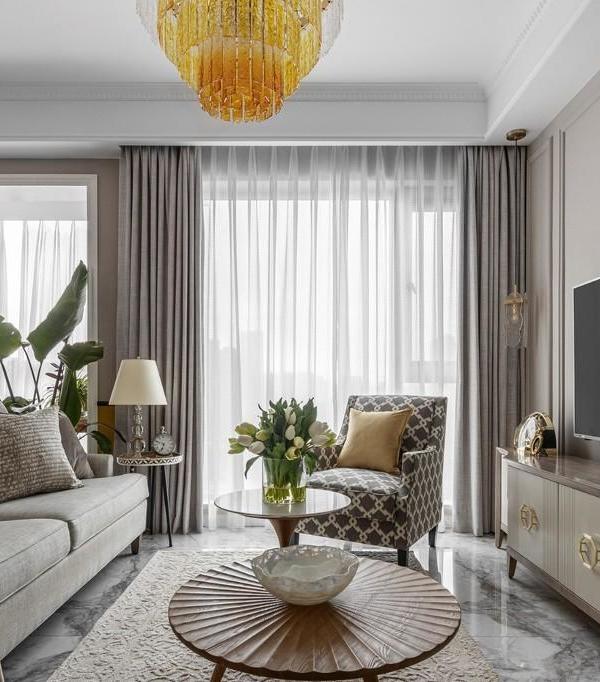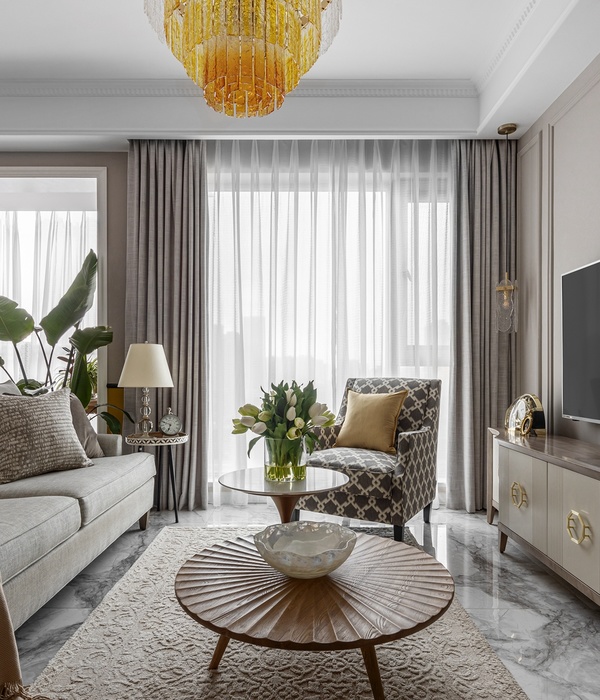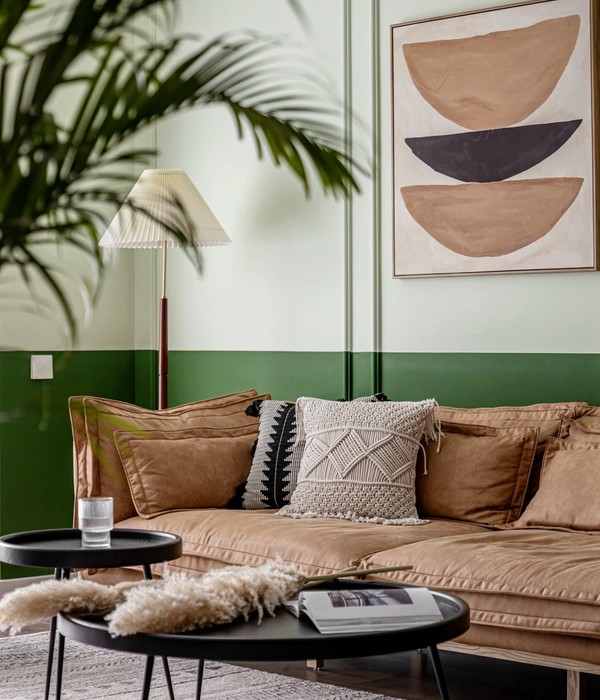本项目坐落于日本千叶Kisaradu郊区独立住宅小区陡峭的边缘地带,是kurosawa kawara-ten事务所为一对老夫妇设计的周末别墅住宅。设计团队首次勘察现场时,场地被茂盛的花草覆盖,场地周围景观优美、绿树成荫,充满了自然的气息。在这样一处古老的郊区住宅区内,如此富有自然气息的住宅场地是非常难得的。怀揣着终有一天能够在这里建造一座周末别墅的愿望,房屋的主人十年来一直精心护理着场地中的绿植,且每周都要在这里进行露营野餐。他们始终憧憬着这样一种理想的生活:寻一个平静的周末,来到这座位于郊区的别墅之中,吃着花园里采摘的新鲜蔬菜,围在炉火旁休憩谈天,将东京的繁忙与嘈杂暂时抛于脑后,安稳地睡上一觉。
▼项目与周边环境鸟瞰,aerial view of the project and surrounding environment
▼场地入口一侧鸟瞰,aerial view from the entrance of the site
We planned a weekend house for an elderly couple on a site with a steep slope which was the edge of a suburban detached housing complex in Kisaradu Chiba Japan. At the first time we visited, there were lots of flowers and plants which had been grown already. Also lots of trees had been leafy green. The space had a rich nature which is rarely seen in such an old suburban residential area.The owner has been gardening, picnicking with fire every once a week for a decade with a wish to build a weekend house someday. They have been hoping that have the lifestyle as having a calm weekend with eating fresh vegetables from the garden, spent some time in front of the fire and just a sleep for stepping back from busy Tokyo.
▼近景鸟瞰,closer aerial view of the house
▼二楼采用悬臂式结构,形成独特的空间比例,the upper floor is cantilevered to form a unique spatial proportion
本项目始于屋主人“希望设计出美丽的房子”的需求,屋主人自青少年时代起就有着想要进入建筑设计行业的理想。因此,kurosawa kawara-ten事务所采用了一种不同寻常的设计方法,通过为屋主人讲解建筑历史、风格等方面的知识,鼓励他们自己探索出理想中的住宅形象与空间布局。在这个过程中,设计团队归纳出三个核心概念:超越普通住宅的形体比例与体量形式、理想的景观视野,以及尽可能小的占地面积以保护场地中的植被。此外,屋主人还希望利用室内墙壁展示他的艺术品收藏,并且让孩子们愿意来这里参加家庭聚会。
▼由街道看建筑,viewing the house from the street
▼由景观一侧看建筑,viewing the house from the nature
The plan had started from the demand “Wishing to design the beautiful house” of the owner who had had the hope to enter the carriage of the architectural department when he was a teenager. Then we tried the designing process by giving the lectures of architecture as history, styles or some others to the owner and finding the plan of the beautiful house for them through such a mutual way. So we found three important concepts for designing the house: a unique proportion that couldn’t be seen in normal houses, the views to the outside and the minimum footprints that prevent killing the plants. Also the owner needed the walls to put the artworks he has and he wanted his sons willingly visit the house for family gathering.
▼住宅外观近景,closer exterior view of the house
▼二层悬挑形成的凉廊,veranda formed by the cantilevered floor
场地中的树木与植被限制了住宅的建造范围,设计团队认为采用悬臂结构打造二层体量大于底层体量的建筑形式,才是最大化建筑面积的最佳方式。因此,卫生间浴室等用水设备空间被规划在紧凑的底部楼层中,客厅等生活起居空间则位于二层。这种设计策略,为住宅创造出充足的可使用面积,并将屋主人精心护理的绿色景观引入室内之中。此外,建筑师还对屋顶空间进行了精心的规划,使屋顶成为能够远眺到东京湾的景观露台。
It was limited to the site where it was available for putting the house, avoiding trees and plants. We thought that it was the best way for maximize the floor area, making the first floor smaller and cantilevered the second floor. Putting together the water equipment spaces in the compact first floor and placing the living room in the second floor, it created the room with enough space with a good view of the greener slope they made. And we planned the rooftop space because there was a possibility to view the scenery of Tokyo bay.
▼上部楼层近景,closer view of the upper floor
▼屋顶空间,rooftop space
不幸的是,由于本项目主要由木材建造,因此在疫情期间,木材的缺乏使建设的过程受到了不小的冲击。另一方面,设计团队从当地林业部门了解到,许多被砍伐的木材,由于疾病以及2019年台风造成的破坏而没有流入市场。因此,建筑师决定利用这些木材来建造本项目。实施的具体过程是:首先林业工会砍伐树木,然后设计团队将这些木材于当地进行初步的切割修整与干燥,之后再将这些经过初步处理的木材送到工厂中进行进一步的预制加工,最终运输到建筑工地中建造该住宅。对于那些习惯了采用廉价的进口木材或市场上销售的木材的建造者来说,这个过程难免被认为是复杂且困难的。但实际上,采用当地树木建造房屋却有着成品木材不具备的优势。稀有木材代替了层压木材构成了建筑的主要横梁,进而营造出天然且丰富的室内氛围。同样的木材也被运用在外立面上,为建筑赋予了独特的外观与肌理效果。
Unfortunately the plan suffered the situation called woodshock which was caused by COVID-19 pandemic. On the other hand, we know from the situation of the local forestry that there are some problems such as spreading disease and neglected destroyed trees by a huge typhoon in 2019. There are lots of cutted trees with no plan for distribution to the market. Then we decided to try using these trees for building the house. The process was, first the forestry union cut the trees, second we brought them to the cutter for cutting and drying, third brought cut lumbers to the factory of pre cutting, finally built the house at the construction site. So, it was thought difficult and complex for the constructor who had been used to the way to build the houses by cheap imported lumbers or lumbers distributed at the market. But it was rather easy to use the local trees to build the house. Replacing the laminated wood to rare wood as big beams, it made the atmosphere rich, and also using those woods as exterior paneling made the outfit special.
▼入口与楼梯,entrance and staircase
▼楼梯,staircase
▼当地木材制成的建筑结构,building structure made of local wood
▼上部楼层入口,entrance of the upper floor
由于住宅的上部楼层采用了悬臂式结构,并由木材建成,因此在空间布局方面非常难以规划。面对这种情况,结构建筑师采用较厚的木材打造出稳固的桁架结构,使建筑面向景观斜坡的一侧具有理想的开放程度与结构刚度,建筑的另一侧则采用了饰面薄板进行进一步的加固。桁架构成的三角形开口被嵌入玻璃形成开窗,为室内引入了独一无二的景观视野。在室内,桁架结构暴露于空间当中,同时起到了厨房置物架或悬挂吊床的作用。
Though the cantilevered second floor made by a wooden structure was very difficult to plan. The structural architect answered as thick lumber trusses made the slope side open and rigid, the other side made by structural veneers for the strength. Putting the glasses to the triangles made by trusses, it made views from the interior unique. These trusses are shown in the interior, but they are used as the selves for the kitchen or hanging the hammock.
▼二层起居空间概览,overall of the upper floor
▼由客厅看餐厅,viewing the dining area from the living room
▼餐厅,dining area
▼三角形开窗构成独特景观视野,the triangular windows form a unique view of the landscape
▼厨房,kitchen
▼厨房开窗细部,details of the window
在严格的预算限制下,大部分的室内装饰采用了最质朴的形式,最基础的石板,石膏板,结构纤维板和结构单板构成了空间中灰色与木色交织的主色调。建筑底层外墙采用了木板,二楼则采用了镀锌板,以便这对老夫妇的后期维护工作。
Most interior finishes are shown the foundations barely by the strict limitation of the budget. Then these materials made the space glay and wooden, the slab of the foundation, plaster boards, structural fiber boards and structural veneers. The first floor exterior wall is wooden panels, second floor is galvanized panels for easy maintenance by the elderly owner in the future.
▼卧室,bedroom
▼底层书房,study room on the ground floor
▼底层家务间与卫生间,housekeeping room and bathroom on the ground floor
随着城市的发展,人们梦想中的理想花园与丰富的自然空间变得愈加遥不可及,一代又一代的人将土地分割得越来越小,花园树木被砍伐一空然后被改造为光秃秃的混凝土停车库的例子屡见不鲜。因此,能够围坐在炉火前感受片刻土壤和草地气息变成了一件近乎“奢侈”的事情。如果你也是这样想的,不妨在城郊也寻一处宁静之地,在这里建造一座逃离城市的周末住宅,它所带给你的将比每年只去一次的豪华度假村多的多。
It is gradually making the distance from the rich nature which was dreamed in the garden cities, succeeding generation to generation makes land lots split smaller by smaller, cutting trees of garden as a bald concrete covered carport. It is very rich and luxual having the time spent with a small fire and breeze smells of soil and grass. If so, we could propose the example of having your base in the commutable suburbs as a “spending suburb” instead of luxual resorts where you visit once a year.
▼外观夜景,exterior night view
▼夜景鸟瞰,aerial night views
▼平面图,plans
▼立面图,elevations
▼剖面图,section
Details
Project size 66 m2
Site size 1727 m2
Project Budget USD 200,000.00
Completion date 2022
Building levels 2
Project team
kurosawa kawara-ten Architect
{{item.text_origin}}

